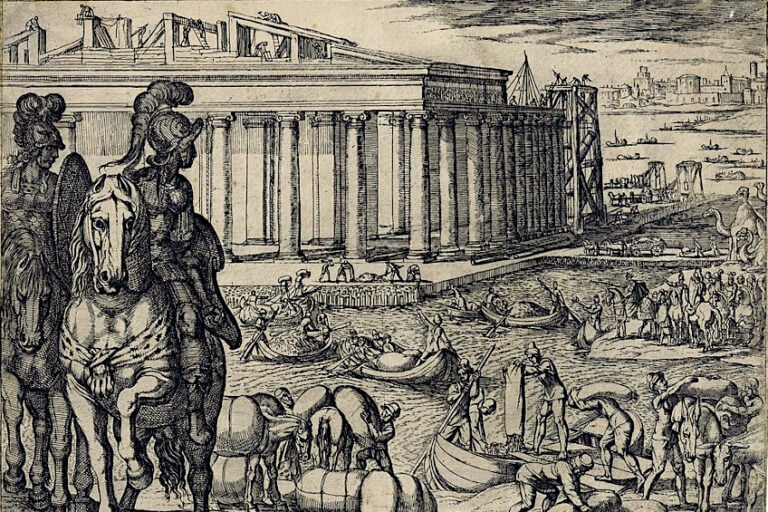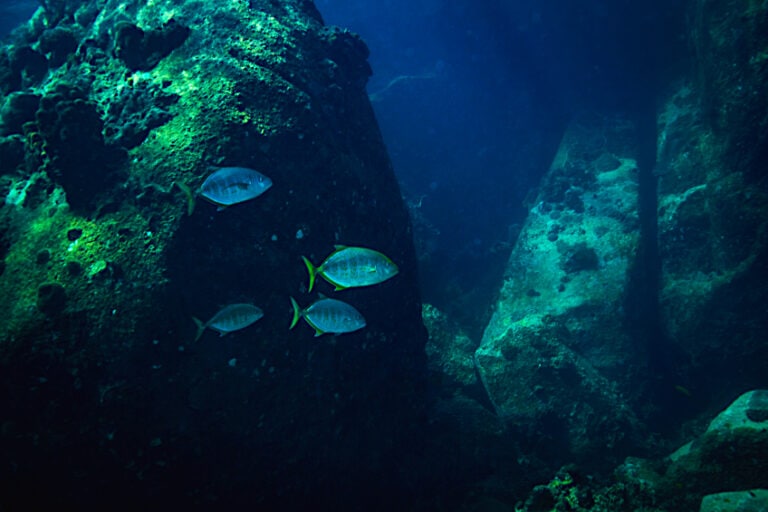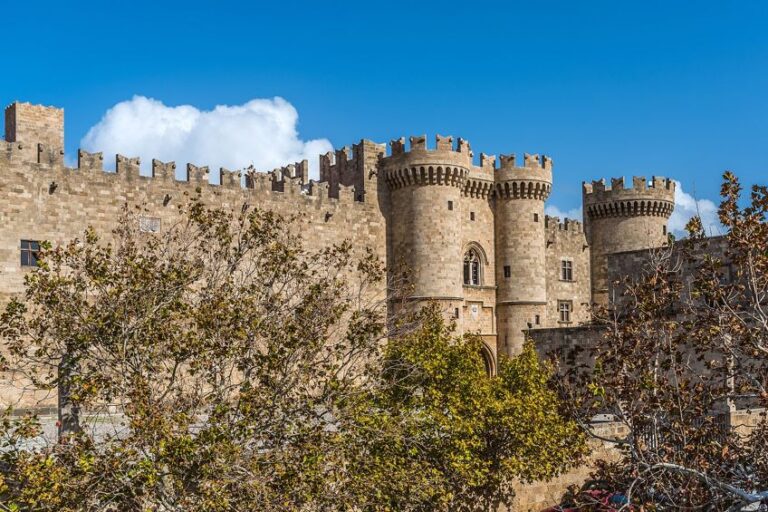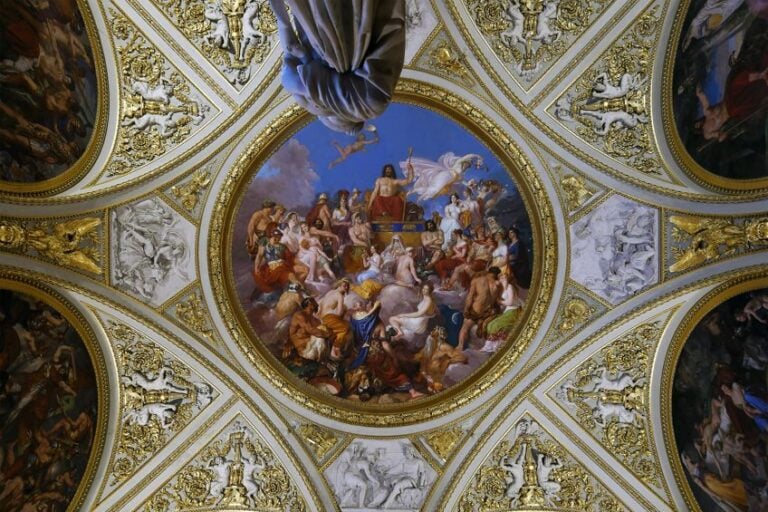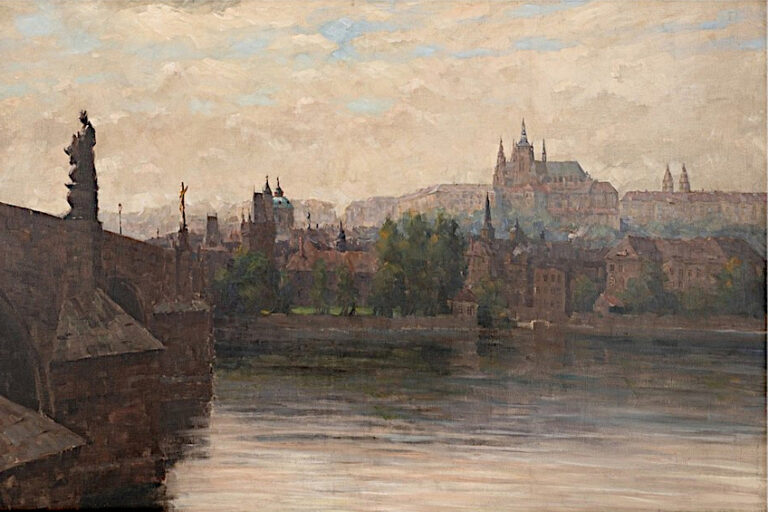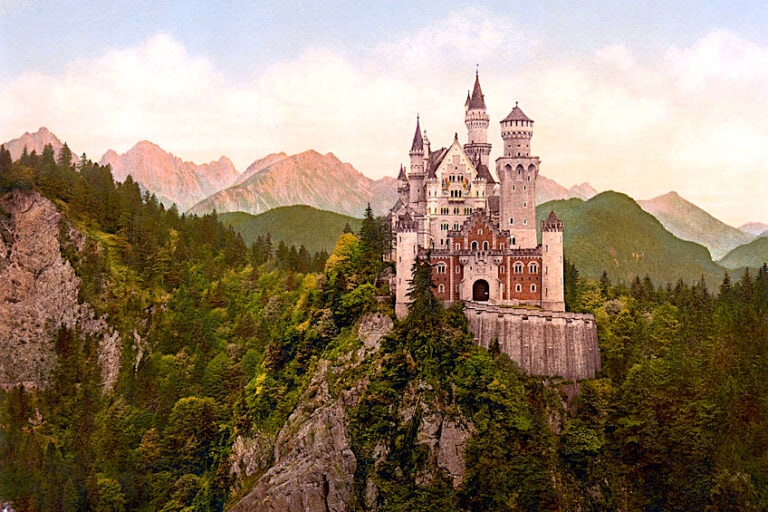Temple of Dendur – The Ancient Wonders of the Egyptian Temple
Throughout human history, ancient societies as a whole were largely collaborative, learning from one another and adapting to survive. In an ideal world, this would have involved teaching one another about different materials, techniques, locations, food sources, minerals, and concepts. Unfortunately, differences in languages, cultures, and religious beliefs often meant that one culture would learn about another through violent conflict and/or subjugation, often resulting in facets of said culture being lost. This wasn’t always the case though, and a good example of this is the temple of Dendur. Let’s have a look at what this temple is, why it was built, how it was constructed, and where it is today.
Contents
What Is the Temple of Dendur?
| Architect | Augustus Caesar |
| Date Created | 23 BCE |
| Materials | Nubian sandstone |
| Dimensions (m) | 6.40 × 6.40 × 12.50 |
| Location of Discovery | Tuzis (later Dendur), Nubia, Egypt |
| Current Location | The Metropolitan Museum of Art, New York City, United States |
The Temple of Dendur is a construct that was built during the Roman occupation of Egypt. The purpose of its construction was not only to appease then-ruler Augustus Caesar, but to win over the hearts and minds of the people. The temple was constructed around Dendur, Nubia about 80 kilometers due south of what is now Aswan, and was designed to be a place of worship for the Egyptian Goddess Isis. Augustus’s goal was to make his name and image synonymous with that of Isis to ensure that he would live on in the minds of his subjects.
The construction of the temple took place around the year 23 BCE, and was not only dedicated to the aforementioned Goddess but also allowed those who visited it to lay down offerings for the emperor himself.
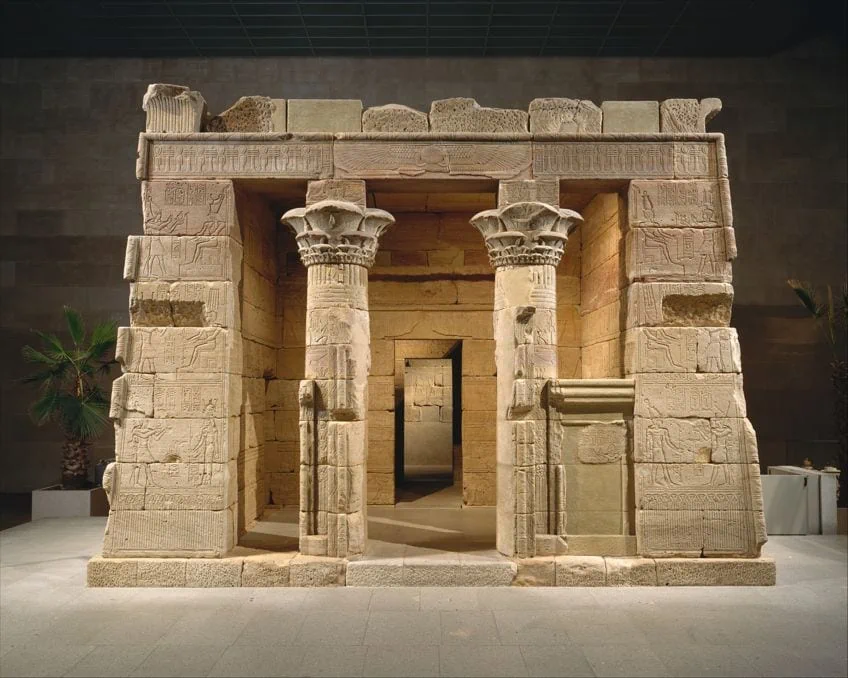 The Temple of Dendur (23 BCE); Metropolitan Museum of Art, CC0, via Wikimedia Commons
The Temple of Dendur (23 BCE); Metropolitan Museum of Art, CC0, via Wikimedia Commons
The construction of the temple seems to have been influenced by the then emperors’ recent victory and takeover of the Roman empire at large, Augustus had defeated then-emperor Mark Antony as well as Cleopatra and sought to make his mark as we mentioned previously. However, other than the temple of Dendur he isn’t noted as building many other temples in the vicinity of Nubia.
Even though the emperor Augustus commissioned the construction of the temple it was the then-governing ruler of Egypt named Petronius who oversaw the construction of the temple and some of the finer details associated with it. Due to the deity, it would be dedicated to and the fact that it would be directly associated with the emperor this would have made complete sense.
Why did Augustus choose to dedicate the temple to Isis out of all of the available Gods in the pantheon you ask? Well, Isis was the principal deity of Dendur. This would further legitimize his rule by winning over the hearts and minds of the cults associated with Isis, namely Pihor and Pedesi, allowing him to rule the region relatively unopposed.
Many kings throughout history fancied themselves gods, and Augustus was no different. What is the easiest way to ascend to godhood then? Well, simply associate yourself with an existing popular deity. Thus, whenever offerings such as wine and incense were brought to the temple for worship, some would be brought for the emperor as well.
Description of the Temple of Dendur
In order to understand the temple of Dendur it is important to understand the style and architecture of any Egyptian temple first. Temples were seen as the home of the gods, and their construction and styling were meant to represent the natural work around them, reflecting the god/goddess’s dominion over these facets of existence.
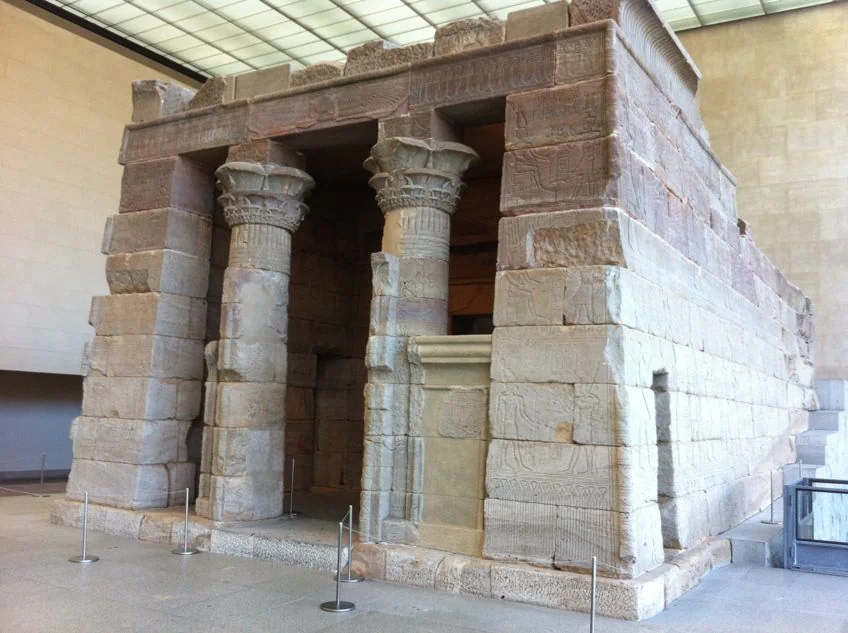 The Temple of Dendur (23 BCE); RaviSarma, CC BY-SA 3.0, via Wikimedia Commons
The Temple of Dendur (23 BCE); RaviSarma, CC BY-SA 3.0, via Wikimedia Commons
The Entrance
A good example of this is how the base of the temple is lined with various images of plants and water. The plants seem to be sprouting out from the water below, much the same way that reeds do from the Nile River. This is believed to be a representation of the god Hapy, who happens to be the patron god associated with the Nile River. The front of the temple has symbolism attached to it too. One of the most noteworthy features of the temple’s face has to be the two massive columns that seem to stretch up towards the sky, and just like the images on the base of the temple, they have papyrus (an important part of Egyptian society) wrapped around them. The symbolism doesn’t end there though.
If you were to look at the gate that grants entrance to the temple you will notice a sort of plaque in its center.
This is known as the sun disk, and as you might have guessed it represents the sun which was an important part of the Egyptian belief system. On either side of the sun disk, there are two outstretched wings representing the Sun god Horus, intertwining two solar symbols. Other aspects of the entrance that evoke deeper meaning beyond architectural aesthetics are representations of the sky. Just as the wings on the temple gate represent the presence of the sun god Horus, wings can be found on the ceiling of the entrance gate representing the sky, really driving home the symbolism of the natural work in ancient Egyptian temple design.
The Primary Exterior
The outer walls of the temple are covered with various depictions of deities and symbols representing various aspects of everyday life and religious beliefs. One of the more noteworthy is the depiction of the king making an offering to gods in the pantheon, all while they face him holding scepters of varying sizes and an ankh, the Egyptian symbol for life. Representations of deities were considered to be very important in Egyptian culture, so it comes as no surprise that these sunken reliefs cast emphasizing shadows on the figures of the gods when exposed to sunlight.
The deities themselves are easily identifiable via the presence of crowns on their heads in addition to their names being inscribed next to them.
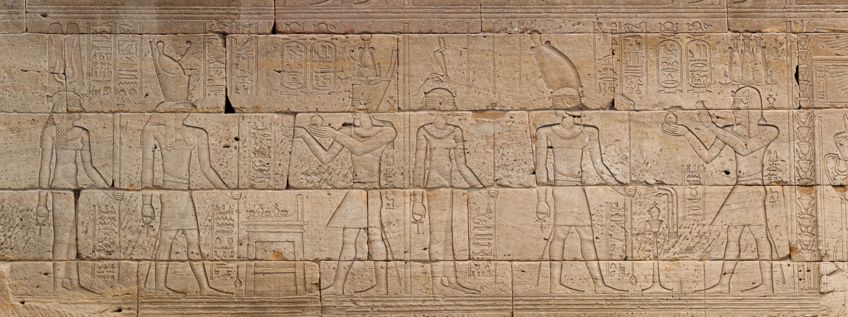 The Temple of Dendur, two vignettes depicting offering scenes on the southern wall of the temple (23 BCE); Metropolitan Museum of Art, CC0, via Wikimedia Commons
The Temple of Dendur, two vignettes depicting offering scenes on the southern wall of the temple (23 BCE); Metropolitan Museum of Art, CC0, via Wikimedia Commons
The king is also paid close attention to in his representation. He is seen in all of his royal regalia that would have been used for ceremonial purposes and is also relatively easy to identify due to his headdress, not to mention that the word Pharaoh is inscribed on the side of his head. This would indicate that the Pharaoh is close to the gods. The “Pharaoh” in the context of this depiction was not one of Egyptian descent as one might think. It’s actually Augustus Cesar being portrayed as the Pharaoh, which is fair enough considering that he was the ruler at the time of its construction.
The sons of a local leader at the time are also pictured on the sides of the structure.
The First Room
The first room of the temple sets the mood for the rest of the interior pretty well. There are various depictions of the Pharaoh making offerings to the many deities of the Egyptian pantheon much the same as can be seen by the marking on the exterior of the structure. This is not uncommon in most temple structures. The depictions themselves are not indentations like the ones on the exterior of the structure, instead, they appear to be raised (or embossed) shapes and figures. Why? Well, due to a lack of natural light being able to enter this part of the temple, the shapes on the walls are easily identifiable with what little light would have been available.
Standing in this room will allow you to view the rest of the temple by looking straight down its center.
You should be able to see the central chamber in which most offering ceremonies would take place and the back of the temple where the sanctuary of Isis is located. As you can probably tell, the shape of the temple is quite linear, which makes sense considering its size. Unfortunately, there aren’t any other significant carvings past the entrance of the building, and whether this is due to time constraints or that these sections of the temple are devoted to worship is up for debate. However, on the door frame of the sanctuary of Isis, there is a depiction of Pihor (the son of a local nobleman) worshiping the goddess, and his brother Pedesi worshiping Osiris.
What Is the Temple Made of and How Was It Made?
You might have noticed that compared to others built at the time, this Egyptian temple is quite small by comparison, especially considering that it was built to honor both the principal deity of the region and the ruling king at the time. Why the temple was built in such small stature is unclear, but despite this, it is still one of the more well-known temples of the era. The temple itself consists of 580 tonnes of sandstone, which was a fairly common building material in the region at the time.
Due to the timescale and size of the structure it is believed that local architects would have worked in conjunction with Augustus’s men not only on the structure of the building but in the creation and execution of the inscriptions as well.
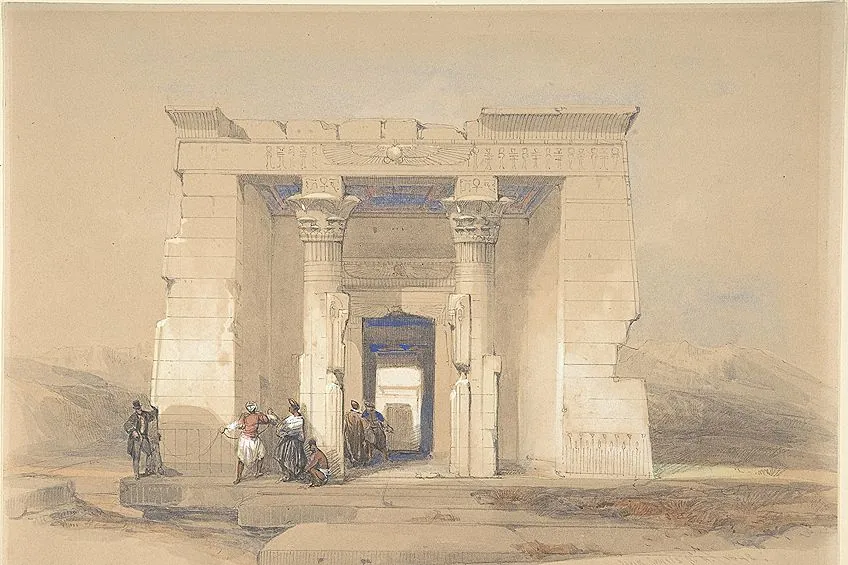 The Temple at Dendur, Nubia (1848) by David Roberts; David Roberts, CC0, via Wikimedia Commons
The Temple at Dendur, Nubia (1848) by David Roberts; David Roberts, CC0, via Wikimedia Commons
The construction method is simple. Sandstone blocks would have been created using local methods and compiled in the configuration that we know and love today. Inscriptions would have been added to the relevant pieces during the “minting” period, and then simply placed where they were intended to be later on. This modular construction method is relatively common in temples of the time and was even used in the construction of the pyramids of Giza.
This makes sense considering the scale of these structures, as it would not have been feasible in regard to labor and effort to construct any of the aforementioned in a monolithic fashion.
Where Is the Temple of Dendur Now?
While one might expect that the temple would still be in Egypt right now, it’s actually done quite a bit of traveling since its construction. How does a 580-tonne sandstone temple travel the world you ask? Well, you move it. This being said, let’s have a look at why and how this relatively huge temple was moved to different locations around the world.
In the 1960s, Egypt sought to construct the much-needed Aswan dam that would have led to the monuments of Nubia (including the Dendur temple) being submerged. This led to UNESCO gathering the support and resources of 50 different countries in an attempt to save the Nubia monuments, resulting in various countries donating resources in order to safely move these monuments.
This led to earth-moving equipment, photographers, money, Egyptologists, and architects being donated to the cause. The temple of Dendur was studied for around two years in order to determine the best way to deconstruct and move it before the move was eventually executed. The temple would remain in Egypt until 1965.
That same year, Egypt would present the temple to Dendur to the United States as a show of thanks for the nearly 16 million US dollars it had donated to the effort of preserving the monuments of Nubia. The monument was accepted by then-first lady Jaqueline Kennedy in 1967 on behalf of the National Foundation for The Arts and Humanities.
Once in possession of this institution, they held a competition to decide which institution would have the privilege of displaying the temple. This would come to be known as the Dendur Derby. As many institutions would go on to pitch ideas as to why they should be allowed to display the temple and where they would have it displayed.
Some institutions recommended placing the temple on the banks of various rivers, but these ideas were rejected on the basis that the presence of moisture would inevitably erode the temple’s sandstone. Eventually, then President Lydon B. Johnson awarded the display of the temple to the Metropolitan Museum of art, as they had the space to display the temple indoors while replicating the Egyptian climate to ensure its longevity.
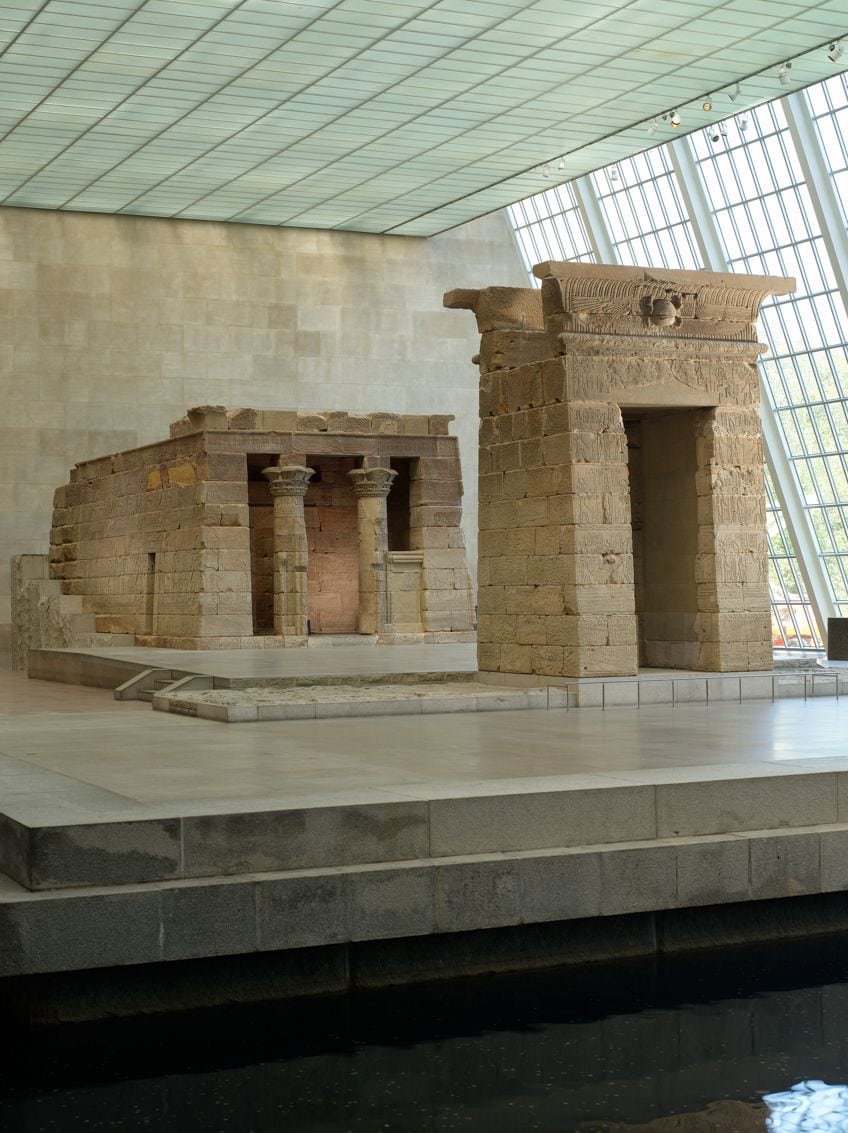 The Temple of Dendur (23 BCE); Metropolitan Museum of Art, CC0, via Wikimedia Commons
The Temple of Dendur (23 BCE); Metropolitan Museum of Art, CC0, via Wikimedia Commons
The temple display would be open to the public in July 1975. Considerable effort went into the display of the temple, including a sloped glass ceiling, a reflecting pool, and a climate control system, effectively functioning as a large “display case” as one critic put it. If you’re wondering where to find the Egyptian temple of Dendur, it can still be found in the Met Museum to this day, so why not give it a look if you find yourself in the area?
Now that you know what the temple of Dendur is, why the temple of Dendur was constructed, what the temple is made of, and where to find the Egyptian temple of Dendur today, it’s time for you to get out there and put your newfound knowledge to the test! This is a truly remarkable artifact, and is definitely worth a look should you find yourself in a position to check it out.
Frequently Asked Questions
What Is the Roman Temple of Dendur?
The temple of Dendur was a temple constructed and commissioned by the then-Emperor of Rome. This was done to legitimize his newfound rule and leadership and to win the hearts and minds of the locals by associating himself with the principal deity of the region.
Who Owns the Temple of Dendur?
While the temple was originally owned by the Egyptian government, due to the generous donations by the United States in an effort to preserve it and other artifacts back in the 1960s, it was gifted to the United States in 1965. Since then, the United States has retained ownership of the temple.
Can You Go Inside the Temple of Dendur?
While most artifacts in the museum are considered to be display-only, there are exhibits that are somewhat interactive, and the temple of Dendur is one of them. One can interact with the reflecting pool and the temple at the exhibit, within reason of course.

I am deeply passionate about history and am constantly fascinated by the rich and complex stories of the past. As the editor-in-chief of learning-history.com, I have the opportunity to share this passion with a wide audience through the creation and distribution of engaging and informative content about historical events, persons, and cultures. Whether it’s through writing articles and blog posts or creating videos or podcasts, I strive to bring the past to life in a way that is both accurate and enjoyable. My expertise in history, combined with my strong writing and communication skills, allows me to effectively communicate complex historical concepts and make them accessible and interesting to a wide range of readers. I am truly grateful for the opportunity to share my love of history with others through my work on learning-history.com.

